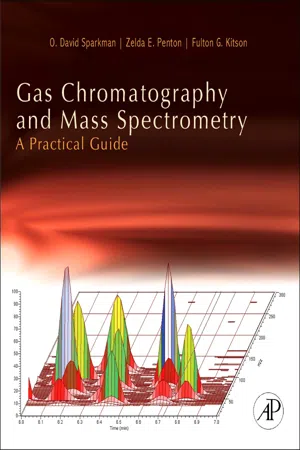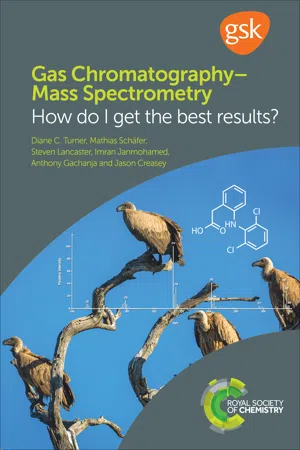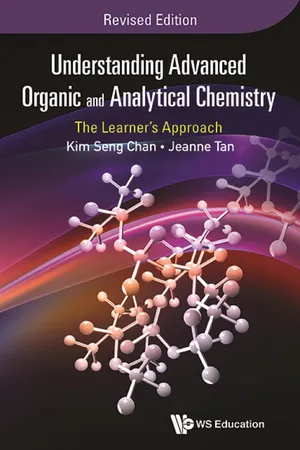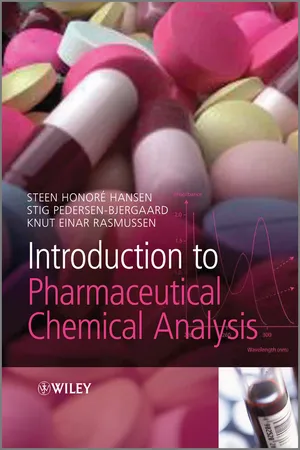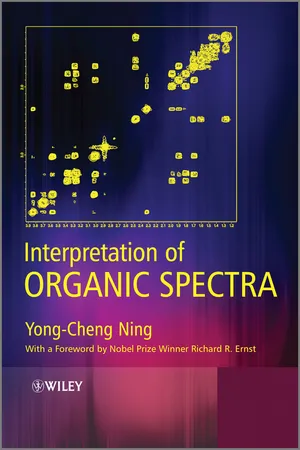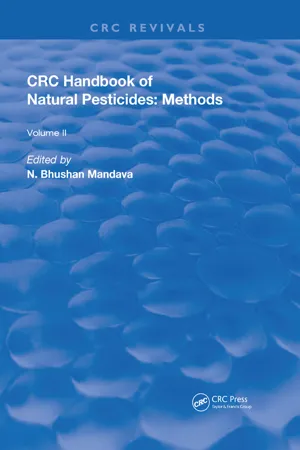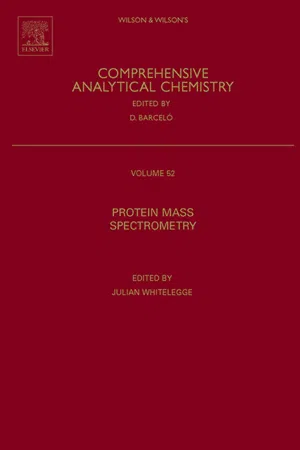Chemistry
Interpretation of Mass Spectra
Interpretation of mass spectra involves analyzing the patterns of ion fragmentation to determine the molecular structure of a compound. This process includes identifying the molecular ion peak, analyzing the fragmentation pattern, and using mass spectrometry databases to match the observed mass spectrum with known compounds. Interpretation of mass spectra is a crucial tool for identifying unknown compounds and elucidating their structures.
Written by Perlego with AI-assistance
Related key terms
Related key terms
1 of 4
Related key terms
1 of 3
9 Key excerpts on "Interpretation of Mass Spectra"
- O. David Sparkman, Zelda Penton, Fulton G. Kitson(Authors)
- 2011(Publication Date)
- Academic Press(Publisher)
Chapter 5. Mass Spectral Data InterpretationWhen the word “interpretation” is used in conjunction with “data acquired using the continuous measurement of spectra mode with an EI GC/MS system,” it usually means the elucidation of the structure of an analyte based on the peaks that appear in the mass spectrum. The purpose of this structural determination is usually to identify an individual substance. Figure 5.1 is the EI mass spectrum of cocaine. The molecular ion (M+• ) * peak can be used to identify the molecular weight of the compound and possibly its elemental composition. The peaks in the spectrum representing the fragment ions can reveal the structure of parts of the molecule. The differences in the m/z values of the M+• peak and the fragment ion peaks (the dark matter of the mass spectrum) also hold information about the structure of the molecule.* In mass spectrometry, the molecular ion is an ion that has the same atoms connected in the same way as the neutral molecule from which it was formed. The molecular ion is formed by the removal of the (M+• ) or the addition of an electron (M−• ) from or to (respectively) the original molecule. The symbol for the molecular ion includes a superscript+or – to indicate the fact that the species is an ion and to show the sign of the charge. This is followed by a dot, which shows that the ion has an odd number of electrons. All molecules have an even number of electrons; therefore, the addition or removal of an electron from the molecule results in a charged species that has an odd number of electrons. The nominal mass (see below for definition) of the molecular ion and the molecule are the same. For compounds that will be amenable to GC/MS, an unambiguous elemental composition of the molecular ion can be determined from its accurate mass without regard for the removed or added electron.Figure 5.1 EI mass spectrum of cocaine. The M+• peak at m/z 303 is easily identifiable because it is the highest m/z value peak in the spectrum that is not due to background or is not an isotope peak; and the peak at the next lower m/z value represents a loss of 31Da, which could correspond to a • CH3 radical. Because the numeric value of the M+• peak is an odd number, the analyte is known to have an odd number of nitrogen atoms (Nitrogen Rule- eBook - ePub
Gas ChromatographyMass Spectrometry
How Do I Get the Best Results?
- Diane C Turner, Mathias Schäfer, Steven Lancaster, Imran Janmohamed, Anthony Gachanja, Jason Creasey(Authors)
- 2019(Publication Date)
- Royal Society of Chemistry(Publisher)
7 Basic Aspects of Mass Spectra InterpretationThis chapter will address the following questions: How do I use mass spectrometry for qualitative analysis? How to identify unknown compounds? How do I determine the quantity of a compound with a GC-MS?
7.1 What Information Does the Molecular Ion in EI-MS [M]+ ˙ Give Me?
7.1.1 What Is a Molecular Ion?
We have seen that the molecules can be ionized using different methods. The nature of the molecular ion is dependent on the way it was formed. In electron (impact) ionization (EI)-MS the molecular ion [M]+ ˙ is generated by loss of an electron (Section 5.4.1, Chapter 5). The respective molecular ion must have an odd number of electrons and is a radical cation = OE+ ˙ (OE+ ˙ odd electron number ion). In chemical ionisation (CI) however, the choice of the reagent gas determines whether the molecular ion is an OE+ ˙ type ion, generated via charge exchange, or is produced via protonation (see Section 5.4.2, Chapter 5). In the latter process molecular ions are closed shell species of the type [M + H]+ and have an even electron number (EE+ ions). It is therefore important to note that a correct interpretation of a mass spectrum starts with the correct understanding of the ionisation method used. The nature of the molecular ion is especially important for the correct determination of molecular compositions on the basis of accurate ion mass measurements and is also crucial for the correct understanding of fragmentation patterns.In the following discussion we want to concentrate on the interpretation of EI-MS spectra as those are by far the most important ones in GC-MS. As discussed in Section 5.4.1 in Chapter 5 molecular ions [M]+ ˙ generated by EI-MS can either be stable or unstable and the relative intensity of the molecular ions relies strongly on the nature of the analyte. Aside from that, the elemental composition is reflected in the isotopic signal pattern of the molecular ions [M]+ - eBook - ePub
Introduction to Mass Spectrometry
Instrumentation, Applications, and Strategies for Data Interpretation
- J. Throck Watson, O. David Sparkman(Authors)
- 2013(Publication Date)
- Wiley(Publisher)
molecular mass machines . At one time, even electron ionization (EI) was used primarily for analyte characterization based on nominal mass. The challenge in using mass spectrometry to determine mass is in recognizing the peak in the mass spectrum that represents the intact molecule. As demonstrated in an earlier section of this chapter, the elemental composition of an ion can be determined using accurate mass measurement or isotope peak intensities, but in order to determine the elemental composition of an analyte, it is necessary to identify the peak in the mass spectrum that represents the intact molecule. Therefore, recognition of the peak representing the intact analyte molecule is one of the most important aspects of interpreting mass spectra.EI mass spectrometry can complicate the goal of determining the nominal mass of a molecule because the molecular ion of some compounds is so unstable that none survive to give rise to a discernible peak; i.e., for certain compounds, the molecular ions fragment completely. As pointed out earlier, only about 80% of the compounds in the NIST/EPA/NIH Mass Spectral Database produce EI mass spectra that exhibit a discernible peak for the molecular ion. Another 18% of the compounds represented in the library produce mass spectra in which the M·≠ peak has a relative intensity of only 1 to 5%. In some cases, a low intensity M·≠ peak may not be detected because of the operating mechanics of the instrument, such as the need for rapid data acquisition when using a narrow-bore capillary (i.d. of 32 μm or less) with GC/MS on scanning beam-type instruments such as the transmission quadrupole or magnetic double-focusing mass spectrometer.In the case of liquid introduction of the sample under atmospheric pressure (ESI, APCI, APPI, etc.), the mass spectrum may be complicated by the presence of peaks that represent protonated or deprotonated species that are clustered with one or more molecules of one or more components of the solution containing the analyte. In the case of positive-ion ESI, there is the problem (or advantage) of adduct formation with alkali ions. There is also the possibility of forming multimers of the analyte. Furthermore, multimers of solvent molecules can give rise to significant peaks in the mass spectrum. The task of recognizing the peak that represents the intact molecule, and thus that allows a determination of the mass of the analyte, sometimes can be daunting at best. - eBook - ePub
Understanding Advanced Organic and Analytical Chemistry
The Learner's ApproachRevised Edition
- Kim Seng Chan, Jeanne Tan;;;(Authors)
- 2016(Publication Date)
- WS EDUCATION(Publisher)
CHAPTER 14
Mass Spectrometry
14.1 Introduction
Mass spectrometry is an analytical technique that enables us to determine the chemical composition of a sample and elucidate the structures of compounds based on the mass-to-charge ratio of charged particles.The fundamental principle lies in the fact that charged particles of different mass and charge behave differently in an electric or magnetic field. If we have a beam of positively charged particles moving across an electric field, it will deviate from its original path and get deflected towards the negative plate. If the beam is comprised of negatively charged particles, it will deflect towards the positive plate. All this is in accordance with the concept of like charges repel and unlike charges attract.An atom is electrically neutral since it contains equal numbers of protons and electrons. A beam of atoms moving across an electric field will continue in its path and not be deflected at all. Molecules made up of atoms are also neutral species, so how can we use this technique to identify molecules? We can actually transform these neutral species into positively charged particles through the process known as ionization. Electrons are forcefully removed from atoms (even those which tend to form anions), which makes ionization an energetically demanding but possible process.If a sample containing different molecules is ionized into positively charged species, how do we identify them if they deflect towards the same negative plate? These like charges are differentiated by the amount of deviation from their trajectory, defined as the angle of deflection (θ):The positively charged species with the higher charge experiences greater attractive force exerted by the negative plate and deviates more from its trajectory. For two ions of the same unit charge but different masses travelling at the same speed, the heavier particle has a greater kinetic energy (K.E. = 1/2 mv2 - eBook - ePub
- Steen Honoré Hansen, Stig Pedersen-Bjergaard, Knut Rasmussen(Authors)
- 2011(Publication Date)
- Wiley(Publisher)
Frequently, unknown compounds in GC-MS cannot be identified completely by mass spectrometry because no matching spectra are found in the libraries. In such cases you have to manually interpret the mass spectrum to get structural information (characterization). This information is often combined with complementary data from IR and NMR spectroscopy. Interpretation of Mass Spectra is relatively difficult and requires detailed knowledge of fragmentation patterns of organic compounds. This is beyond the scope of this textbook, but some of the principles of interpretation are discussed in relation to a few examples, to give a flavor of the field.For the manual Interpretation of Mass Spectra, it is common to start from the upper part of the mass scale because the fragments with the highest masses are those most specific for the structure. First we try to locate the molecular ion (M)+ , to possibly get the molecular weight of the unknown. With electron ionization, there are no signals at higher masses than the molecular ion. We therefore look for the molecular ion at the right hand side of the mass spectrum. The highest mass usually does not directly equal the molecular weight, but is shifted one or two mass units [(M + 1)+ or (M + 2)+ ] upwards from the molecular ion because of isotopes and other heavier isotopes.Figure 16.6 shows an example of how to determine the molecular weight. The highest mass with a signal is at 286. This signal corresponds to molecular ions containing one atom (M + 1)+ , while the signal at mass 285 corresponds to the actual molecular weight of the compound (M)+ . There is also a peak at mass 284, but this arises from loss of a H-radical from the molecular ion (M−1)+ .Figure 16.6 Mass spectrum (electron ionization) of morphine (analgesic drug). The signal at mass 286 corresponds to molecular ions with one atom (M +1)+ , while 285 corresponds to the actual molecular weight of the compound (M)+Ions with lower masses than the molecular ion have been formed by fragmentations from the molecular ion. These fragmentations can provide significant structural information. Table 16.2 gives different possible fragmentations directly from molecular ions, the corresponding mass differences and possible structural information that can be derived from the actual mass shifts. Please note that Table 16.2 - eBook - ePub
- Yong-Cheng Ning(Author)
- 2011(Publication Date)
- Wiley(Publisher)
m/z 39 produced from benzene. Five-membered heteroaromatics also produce the fragment:, where X represents NH, O, or S.The mass spectra of the substituted heteroaromatics can be interpreted in the same way as those of the substituted benzene. 4.3.6 Interpretation of the EI Mass Spectrum and Examples 4.3.6.1 Interpretation of the EI Mass SpectrumFor the deduction of an unknown structure, it is necessary to comprehensively analyze several kinds of spectra. The mass spectrum is just one kind of spectra. We will present the interpretation of the EI mass spectrum here.If we deduce an unknown structure only by its mass spectrum, this structure must be a simple one and the conclusion is not reliable. If the structure is complex and we use only the mass data, what we obtain is partial structural information.The steps of the interpretation of the EI mass spectrum are as follows. Determination of the Molecular Ion Peak The reader is referred to Section 4.3.1. We emphasize again that the logical loss of a neutral fragment is the most important criterion for the determination of the molecular ion peak. Determination of the Molecular Formula If the high resolution mass spectrum is available, the molecular formula can be obtained from it. (See Section 4.5.) - eBook - ePub
Handbook of Natural Pesticides: Methods
Volume II: Isolation and Identification
- N. Bhushan Mandava(Author)
- 2019(Publication Date)
- CRC Press(Publisher)
bFIGURE 2. Bar graph of the background mass spectrum.Mass spectra have different sorts of usefulness, depending on the nature of the problem to be solved. If the material in the sample happens to be a known compound whose spectrum has been recorded and preserved in a reference collection, the spectrum of the sample may be compared with those in the reference library until the matching one has been located. The correspondence of the sample spectrum to the reference spectrum then serves to identify the sample or to confirm a tentative identification based upon other data. Frequently, the spectrum of the sample will not be found in the library, but spectra of related compounds, such as other members of a homologous series, may suggest the nature of the processes occurring and lead to a tentative identification, which can be confirmed by recording the spectrum of an authentic sample of the suspected material.In cases in which the sample is a compound not previously known and not closely related to one whose mass spectrum is known, the fragmentation processes that produce the spectrum may be expected to yield information about the molecular structure of the unknown. In simple cases, the mass spectrum alone may make possible the recognition of the structure. In general, however, that is not likely. IR, UV, and NMR spectra, chromatographic properties, and other chemical information such as elemental composition, degree of unsaturation, the nature of other functional groups that can be identified by chemical reactions, together with such physical measurements as X-ray crystallographic data, all contribute to the eventual solution of the problem. The mass spectra of the products of hydrogenation, ozonolysis, and other reactions often provide essential bits of information.35 - Jeroen Kool, Wilfried M. A. Niessen(Authors)
- 2015(Publication Date)
- Wiley-VCH(Publisher)
1 Introduction to Mass Spectrometry, a TutorialWilfried M.A. Niessen and David Falck1.1 Introduction
In the past 30 years, mass spectrometry (MS) has undergone a spectacular development, in terms of both its technological innovation and its extent of application. On-line liquid chromatography–mass spectrometry (LC–MS) has become a routine analytical tool, important in many application areas. The introduction of electrospray ionization (ESI) and matrix-assisted laser desorption/ionization (MALDI) has enabled the MS analysis of highly polar and large molecules, including biomacromolecules. MS is based on the generation of gas-phase analyte ions, the separation of these ions according to their mass-to-charge ratio (m/z), and the detection of these ions. A wide variety of ionization techniques are available to generate analyte ions (Section 1.3). Mass analysis can be performed by six types of mass analyzers (Section 1.4), although quite frequently tandem mass spectrometers, featuring the combination of two mass analyzers, are used (Section 1.5). The data acquired by MS allow quantitative analysis of target analytes, determination of the molecular mass/weight, and/or structure elucidation or sequence determination of (unknown) analytes (Section 1.6).This chapter provides a general introduction to MS, mainly from a functional point of view. Next to basic understanding of operating principles of ionization techniques and mass analyzers, the focus is on data interpretation and analytical strategies required in the study of biomolecular interactions using MS.1.2 Figures of Merit
1.2.1 Introduction
An MS experiment typically consists of five steps: (i) sample introduction, (ii) analyte ionization, (iii) mass analysis, (iv) ion detection, and (v) data processing and interpretation of the results. Sample introduction may involve individual samples or may follow (on-line) chromatographic separation. Mass analysis and ion detection require a high vacuum (pressure ≤ 10−5- eBook - ePub
- Julian Whitelegge(Author)
- 2008(Publication Date)
- Elsevier Science(Publisher)
Chapter 1 An Introduction to the Basic Principles and Concepts of Mass Spectrometry Kym F. Faull, Alek N. Dooley, Frederic Halgand, Lorelei D. Shoemaker, Andrew J. Norris, Christopher M. Ryan, Arthur Laganowsky, Jodie V. Johnson, Jonathan E. Katz Abstract Publisher Summary This chapter introduces the basic principles and concepts of mass spectrometry (MS). If a molecule can be converted into a gas phase ion, it can be interrogated by this technique. Making possible the study of proteins by MS required the development of methods to convert them into the gas phase ions and of techniques to separate the ions and detect them. The principles of these processes are discussed in the chapter. Amino acids, peptides, and proteins have several unique characteristics that make them particularly suitable to MS analysis. First, their ionizable functionalities render these molecules excellent candidates for electrospray ionization (ESI) and laser desorption (LD) ionization. Second, with the exception of isoleucine and leucine, the unique masses of 18 of the 20 common protein amino acids allow for identification on the basis of their mass alone. Third, the universal amide bond that links the amino acids means that the characterization of polymers of amino acids is not confounded with complications that arise from linkage heterogeneity, as is the case with carbohydrate characterization. 1 Opening Remarks The definition of mass spectrometry as the science of manipulating gas phase ions identifies the physical technique with which this volume is concerned [1]. If a molecule can be converted into a gas phase ion it can be interrogated by this technique. Making possible the study of proteins by mass spectrometry required the development of methods to convert them into gas phase ions, and of techniques to separate the ions and detect them. At first this seemed an impossible task
Index pages curate the most relevant extracts from our library of academic textbooks. They’ve been created using an in-house natural language model (NLM), each adding context and meaning to key research topics.
Explore more topic indexes
Explore more topic indexes
1 of 6
Explore more topic indexes
1 of 4
